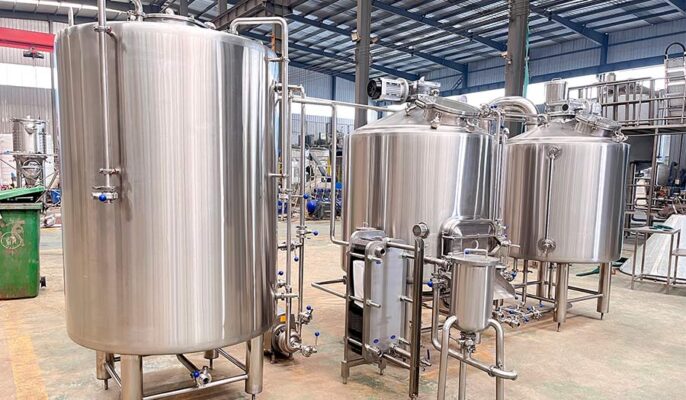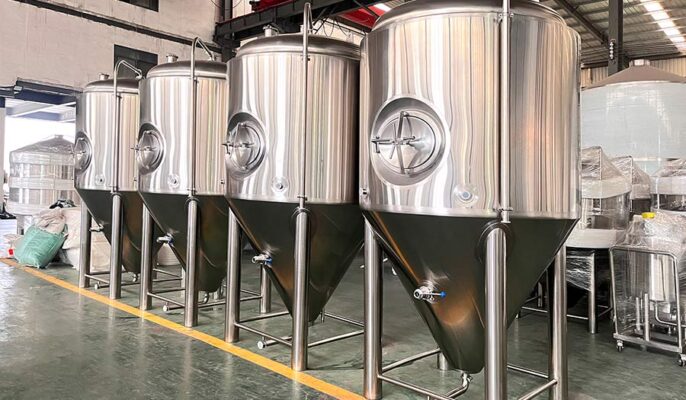Breweries vary in size, and so do brewing equipment costs, with their operations, costs, and revenue determined by their size. Despite the difference in size, the basic brewing process for beer brewing is the same. If you’re considering building a brewery, check out this guide from us to help you better understand brewing equipment costs.
Brewing Equipment Cost
The cost of brewing equipment can vary depending on a variety of factors, such as the size of your brewery, the type of brewing system, and the specific components you need. Here is a general breakdown of the cost of various types of commercial brewing systems:
- Nano breweries (1-3 barrels): $10,000 to $50,000 Nano breweries are smaller, producing less than 1,000 barrels per year. These systems are a popular choice for startups or brewpubs due to their lower upfront costs.
- Small brewery (5 to 15 barrels): $50,000 to $200,000 Small breweries produce 1,000 to 15,000 barrels per year. These systems are popular among small and medium-sized independent breweries that distribute their products.
- Regional Breweries: (15 to 60 barrels): $200,000 to $1,000,000 Regional breweries produce larger volumes of beer, 15,000 to 500,000 barrels per year. These systems are more complex and need greater investments.
- Large Brewery (60+ barrels): $1,000,000 and up Large breweries produce large quantities of beer, over 500,000 barrels per year. These systems can cost millions of dollars, depending on the size, technology, and degree of automation involved.
These costs are rough estimates and will vary based on the specific equipment and components you choose, as well as any customization, shipping, etc. So it’s essential to work with the brewing equipment manufacturer to get an accurate quote based on your specific needs and requirements.

What factors affect équipement de brasserie costs?
Regardless of size, all breweries must estimate their brewery equipment costs, which depend on the amount of beer they need to produce.
Brewery equipment materials
Brewery equipment is made from a variety of materials, with the most common brewing kettles being made from copper and stainless steel.
- Copper brewery equipment: Brewery equipment is made of copper, especially the kettles for boiling wort. Copper ore is available and smelted into its pure form. It transfers heat and within the pot, causing the wort to boil. people started brewing beer in copper vessels because of the great need for high temperatures to boil the wort.
- Stainless steel brewery equipment: In our modern world where everything is end product centric, all large commercial breweries in modern times use stainless steel brewery equipment. While the kettles used there are not made of stainless steel, they do have copper cladding on each kettle to ensure a traditional look but won’t affect the taste unless it’s bleached.
Stainless steel does not react with chemicals, but it does tend to react with chlorine, so proper sanitization will not affect the quality of beer produced by stainless steel brewing equipment. Additionally, stainless steel is a stronger material than copper, so it is not stressed when the wort is boiled at high temperatures. Stainless steel is expensive, but it will be a durable choice for breweries.
New or used brewery equipment
The production cost of commercial brewery equipment also depends on whether you are purchasing new or used brewery equipment for your startup. Of course, new equipment will be more expensive than used equipment, but if the commercial brewing equipment you use is in good condition, it won’t affect your brewing at all (need to check before buying).
The main equipment required for a brewery includes:
- Chaudière
- Bouilloire
- Cuve de fermentation
- Oil storage tank
- Fût
Filters, cooling equipment, bottling machines, refrigerators and cleaning tools are also essential equipment for any size brewery.
Taille de la brasserie
A brewery may refer to the company that brews beer or the building used for the process, but it is also a collective term for all the components a brewery needs during the initial brewing phase. The size of your brewery is a major factor in determining the cost of commercial brewery equipment. If you are doing a larger operation, you will need larger equipment and a larger brewery. The brewery is equipped with mash mixers, hot liquor tanks, whirlpools, boiling kettles and lauter tuns. Typically, brewery capacity is determined in barrels (bbl.). Different companies like ours produce breweries with different barrel capacities based on customer demand. Retail prices for breweries also vary by size. The smallest brewery costs about $50,000.
Sugared mash
The first vessel is used to mash malt and other grains and extract the liquid wort. The second vessel in a two-vessel brewery is used to add hops and other ingredients to the wort and boil the resulting mixture. The wort is then allowed to settle, separating the solid particles from the liquid.

Fermenteur
The fermenter holds the wort, and the yeast converts the sugars in the wort into alcohol and carbon dioxide. These jars should have a tapered bottom to ease the recovery of yeast for later use. Jacketed fermenters allow you to control the mash temperature more , but they are also much more expensive. micet produces fermentation tanks of various sizes and types, you can also consult our engineers.
Char britannique
After the fermentation process is complete, the beer is filtered and pumped into another tank called a secondary fermentation or beer tank. Beer cans allow beer to be further clarified and carbonated before being transferred to bottles, cans, or kegs for drinking. Some brewpubs also serve beer straight from the can.
Fût
Brewers still need kegs to store their beer, even if they transfer it to bottles or cans. They can also sell or supply beer on tap to pubs and restaurants, or serve beer on tap in brewpubs. Kegs also need to be cleaned to prevent the beer from spoiling or losing flavor. Smaller breweries may be able to do without washing kegs by hand, but larger breweries will prefer the greater efficiency and lower cost of a keg washer.
The average cost of opening a brewery
Besides to the cost of the brewing equipment and ingredients you need, the cost of opening a brewery can vary depending on the type of brewery, location, size of the brewery, production capacity, and staffing needs. Whether your brewery offers catering will also have an impact on your start-up and operating costs. On average, the cost to start a brewery ranges from $500,000 to $1.5 million. Even a microbrewery or very small business costs at least $250,000 to start. For larger breweries offering a more diverse craft beer offering, start-up costs can be as high as $2 million.
Estimate brewery equipment costs
From equipment costs to brewery size, construction fees, and licensing, the cost of operating a brewery can vary depending on your specific operation. When estimating the price of an investment, it is important to consider the cost of brewery equipment. there are many types of equipment to choose from, as well as brewery equipment financing options, to get you up and running. Of course, you can also contact micet, and professional engineers will plan and customize your brewery for you.




